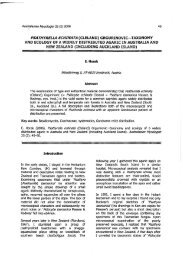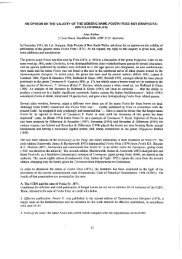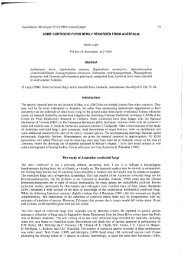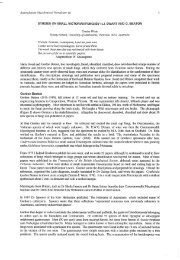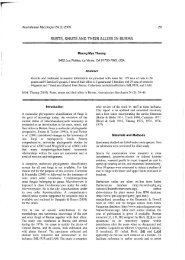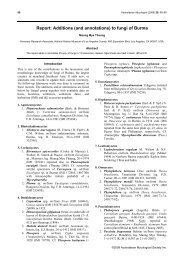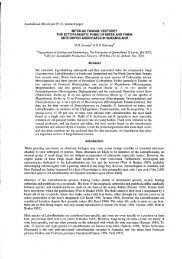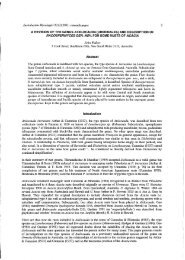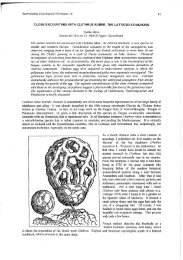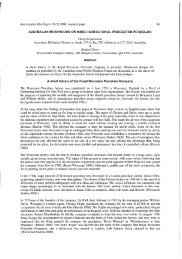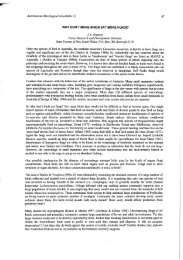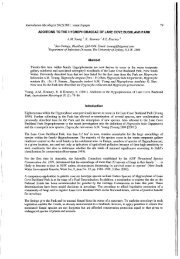Marie Taylor - The Australasian Mycological Society
Marie Taylor - The Australasian Mycological Society
Marie Taylor - The Australasian Mycological Society
You also want an ePaper? Increase the reach of your titles
YUMPU automatically turns print PDFs into web optimized ePapers that Google loves.
OBITUARY<br />
GRACE MARIE TAYLOR, NEE BULMER (1930-1999)<br />
Peter Buchanan, Landcare Research, Private Bag 92170, Auckland, New Zealand -<br />
New Zealand mycology and botany lost one of its most notable teachers, authors, and enthusiasts when <strong>Marie</strong><br />
died after a struggle with lymphoma. In professional and amateur mycological circles, <strong>Marie</strong>'s name is<br />
synonymous with popular publications on New Zealand fungi, illustrated with her beautiful water colour<br />
paintings of mushrooms and other macrofungi. In personal contact she was a very warm and caring person, ever<br />
ready to share of herself and to willingly pass on to her colleagues and students her knowledge, love, and passion<br />
for the fungi, and for the botanical world in general.<br />
<strong>Marie</strong> pursued her early interests in botany to tertiary level, completing her BSc and MSc in botany at Victoria<br />
University, Wellington. Her Master's thesis was on the life history of a species of Ourisia (Bulmer 1951). She<br />
then trained to become a teacher at Auckland Teachers' College and held a teaching position at Wellington Girls<br />
High School, before becoming laboratory demonstrator and then lecturer in botany at Victoria University.<br />
During this time she wrote several taxonomic papers as well as highly practical illustrated keys to New Zealand<br />
native plants (e.g. Bulmer 1958, <strong>Taylor</strong> 1961).<br />
<strong>Marie</strong> married Lawre in 1958, and the first of two sons was born in 1962. Parenting saw an interruption to<br />
lecturing although <strong>Marie</strong> undertook some teaching in Oamaru, in the South Island, where the family lived for 10<br />
years. In 1971, they moved to Auckland. For 20 years <strong>Marie</strong> was senior tutor in the Botany Department of<br />
Auckland University, very much hands-on in running student practical courses, such as those catering for over<br />
700 students in the Stage One biology course. Her enthusiasm, meticulous organisation, and high standards<br />
motivated large numbers of students in the pursuit of botany.<br />
It was in Oamaru that <strong>Marie</strong> began her love affair with the fungi (Braxton 1968) motivated by earlier<br />
encouragement from Dr Greta Cone. As she was already proficient in pen and ink illustration and had a keen eye<br />
for detail, <strong>Marie</strong> soon developed the necessary skills to paint the fungi she collected, until even she was satisfied<br />
with the results! As each specimen was painted it was given a description including, where possible, microscopic<br />
details, and the specimen was dried for further study. <strong>Marie</strong>'s specimens are today housed in the New Zealand<br />
Fungal Herbarium (PDD), Auckland.<br />
<strong>The</strong> first book of <strong>Marie</strong>'s paintings was published in 1970 (<strong>Taylor</strong> 1970), followed by an expanded version<br />
(<strong>Taylor</strong> 1981). This impressive book is without doubt the best known publication on New Zealand mushrooms,<br />
renowned for its insightful and beautifully crafted paintings and descriptive text of 180 of the most frequently<br />
encountered larger fungi. It is a tribute to <strong>Marie</strong>'s accurate illustrations and careful selection from among.the<br />
many hundreds of species that a user of her book can so readily identify many fungi to species level, or if not, at<br />
least spot a probable relative. <strong>Marie</strong> also fashioned easily remembered common names, such as 'fungus icicles'<br />
for Hericium clathroides. With the initial and subsequent printings of the book no longer available, publishers<br />
are considering a posthumous publication incorporating a larger selection of species and additional unpublished<br />
paintings.<br />
National fungal forays began in 1986, and <strong>Marie</strong> and Lawre were committed participants and leaders each year,<br />
<strong>Marie</strong>, along with Barbara Segedin and later Geoff Ridley, as key identifiers of the mushrooms, and Lawre<br />
famous for his culinary skills and lavish menus. <strong>Marie</strong> was always keen to get into the forest each morning,<br />
constantly ready to stimulate others to spot those illusive fungi, and as a born teacher to instruct in their<br />
identification. Back at the lodge after a day in the field, <strong>Marie</strong> continued working with co-forayers to explain<br />
microscopic details and other features of importance in identification, and to prepare paintings of selected<br />
specimens.<br />
Among her taxonomic studies, <strong>Marie</strong> worked for five months in Edinburgh with Professor Roy Wailing,<br />
Edinburgh Botanic Gardens, and published jointly a major work on the mushrooms of the family Bolbitiaceae<br />
(Waiting & <strong>Taylor</strong> 1987). <strong>Marie</strong> described the following new species of mushrooms in conjunction with Dr<br />
Egon Horak, Dr Greta Stevenson, and Roy Wailing (Horak & <strong>Taylor</strong> 1981; Stevenson 1964; Wailing & <strong>Taylor</strong>
1987): Agrocybe olivacea Watling & G.M. <strong>Taylor</strong>, Clitocybe wellingtonensis G.M. <strong>Taylor</strong> & G. Stev.,<br />
Conocybe gracilenta Watling & G.M. <strong>Taylor</strong>, C. horakii Watling & G.M. <strong>Taylor</strong>, C. novaezelandiae Watling &<br />
G.M. <strong>Taylor</strong>, Fayodia grisella G. Stev. & G.M. <strong>Taylor</strong> (Clitocybula grisella (G. Stev. & G.M. <strong>Taylor</strong>) E.<br />
Horak), Leucopaxillus ardesiacus G. Stev. & G.M. <strong>Taylor</strong> (Hydropus ardesiacus (G. Stev. & G.M. <strong>Taylor</strong>)<br />
Singer), Marasmius fishii G. Stev. & G.M. <strong>Taylor</strong>, Mycena minirubra G. Stev. & G.M. <strong>Taylor</strong>, Oudemansiella<br />
australis G. Stev. & G.M. <strong>Taylor</strong>, Phaeomycena fusca G. Stev. & G.M. <strong>Taylor</strong>, Rozites castanellus E. Horak &<br />
G.M. <strong>Taylor</strong>, R. fiisipes E. Horak & G.M. <strong>Taylor</strong>, R. meleagris E. Horak & G.M. <strong>Taylor</strong>, R. pallidus E. Horak &<br />
G.M. <strong>Taylor</strong>, R. rugosiceps E. Horak & G.M. <strong>Taylor</strong>, Tricholoma murinum G.M. <strong>Taylor</strong> & G. Stev.<br />
(Dermoloma murinum (G.M. <strong>Taylor</strong> & G. Stev.) E. Horak), and Xeromphalina racemosa G. Stev. & G.M.<br />
<strong>Taylor</strong>.<br />
At least three fungi have been named in <strong>Marie</strong>'s honour: Cortinarius taylorianus E. Horak, Sydowia 42: 122<br />
(1990); Entoloma marine G. Stev., Kew Bull. 16: 230 (1962); and, Mycena mariae G. Stev., Kew Bull. 19: 54<br />
(1964).<br />
<strong>Marie</strong> was in demand for presenting talks and organising fungal forays for other botanical and naturalist groups.<br />
She was also often the first port of call in New Zealand for visiting mycologists from overseas, and collected<br />
with several including Professors Tsuguo Hongo, Bryce Kendrick, Orson Miller, Ron Peterson, and Kazumasa<br />
Yokoyama. <strong>Marie</strong> was invited to act as hands-on scientific adviser leading the first two Smithsonian Institution<br />
Museum groups to tour New Zealand in 1977 and 1978, and made many friends in the process.<br />
<strong>Marie</strong>'s last major project was the updating and expanding of the 'Botanical names of the flora of New Zealand'<br />
(Wall & Allan 1950). <strong>The</strong> manuscript provides an updated list of the New Zealand flora with the addition of<br />
names of many lower plants and fungi. Sadly, <strong>Marie</strong> could not see the project through to publication but this is<br />
being undertaken by the Auckland Botanical <strong>Society</strong> (Cameron 1999).<br />
<strong>Marie</strong> was my laboratory tutor at Auckland University and I owe a considerable debt to her as a dedicated and<br />
patient instructor of the fungi, and later as a supportive mycological colleague and friend.<br />
<strong>Marie</strong>'s Publications:<br />
Bulmer, G.M. (1951). A Study of the Life-History of Ourisia macrophylla (Hook.). (MSc. <strong>The</strong>sis, Victoria<br />
University of Wellington.)<br />
Bulmer, G.M. (1958). A key to the divaricating shrubs of New Zealand. Tuatara 7,48-61.<br />
Horak, E & <strong>Taylor</strong>, G.M. (1981). Fungi agaricini Novazelandiae. XI. Rozites Karsten. New Zealand Journal of<br />
Botany 19, 353-360.<br />
Ridley, G.S. & <strong>Taylor</strong>, G.M. (1997). 11th New Zealand Fungal Foray, 5-9 May 1997. <strong>Australasian</strong> <strong>Mycological</strong><br />
Newsletter 16, 70-76.<br />
<strong>Taylor</strong>, G.M. (1961). A key to the Coprosmas ofNew Zealand—Parti. Tuatara 9,31-42.<br />
<strong>Taylor</strong>, G.M. (1961). A key to the Coprosmas of New Zealand—Part II. Tuatara 9,43-64.<br />
<strong>Taylor</strong>, G.M. (1967). A key to the species of Coprosma found near Auckland. Auckland Botanical <strong>Society</strong><br />
Bulletin 3-13.<br />
<strong>Taylor</strong>, G.M. (1968). Some New Zealand mushrooms. Tuatara 16, 123-126.<br />
<strong>Taylor</strong>, G.M. (1970). Mushrooms and Toadstools in New Zealand. (A.H. & A.W. Reed, Wellington, 32 pp.)<br />
<strong>Taylor</strong>, G.M. (1975). Comments on Parallela (Chlorophyta). New Zealand Journal of Botany 13,323-324.<br />
<strong>Taylor</strong>, G.M. (1975). Tree Coprosmas. New Zealand's Nature Heritage 6 (Pt 90), 2503-2505.<br />
<strong>Taylor</strong>, G.M. (1981). Mushrooms and Toadstools. Mobil New Zealand Nature Series. (A.H. & A.W. Reed,<br />
Wellington, 79 pp.)<br />
<strong>Taylor</strong>, G.M. (1983). Some common fungi of Auckland city. Tane 29, 133-141.<br />
<strong>Taylor</strong>, G.M. (1986). July 20-Duder's Bush. Auckland Botanical <strong>Society</strong> Newsletter 41,3-4,<br />
<strong>Taylor</strong>, G.M. (1990). Tongariro National Park Fungal Foray-—May 18-21, 1989. New Zealand Botanical<br />
<strong>Society</strong> Newsletter 19,13-16, Cover illustration.<br />
<strong>Taylor</strong>, G.M. (1991). Obituary. Greta B. Stevenson Cone. New Zealand Botanical <strong>Society</strong> Newsletter 23, 7.<br />
<strong>Taylor</strong>, G.M. (1997). Cover illustration: Amanita muscaria. New Zealand Botanical <strong>Society</strong> Newsletter 47.<br />
<strong>Taylor</strong>, G.M. & Buchanan, P.K. (1988). <strong>Mycological</strong> Foray, Te Kauri Lodge, 19-22 May 1988. New Zealand<br />
. Botanical <strong>Society</strong> Newsletter 13, 9-12, Cover illustration.
<strong>Taylor</strong>, G.M. & <strong>Taylor</strong>, L. (1992). Tangihua Fungal Foray, 20-24 May, 1992. New Zealand Botanical <strong>Society</strong><br />
Newsletter 29,19-20.<br />
<strong>Taylor</strong>, G.M. & <strong>Taylor</strong>, L. (1992). Report on Tangihua Foray, May 20-24, 1992. Australian <strong>Mycological</strong><br />
Newsletter 7,14-15, 17-18.<br />
Watling, R. & <strong>Taylor</strong>, G.M. (1987). Observations on the Bolbitiaceae: 27. Preliminary account of the<br />
Bolbitiaceae of New Zealand. Bibliotheca Mycologica 117,1-61.<br />
Acknowledgments<br />
I am very grateful for the help given by Lawre <strong>Taylor</strong>, in elaborating on aspects of <strong>Marie</strong>'s life and<br />
accomplishments, and by some of <strong>Marie</strong>'s colleagues: Catherine (Trixie) Harvey, who read an obituary at<br />
<strong>Marie</strong>'s funeral and later published this (Harvey 1999), Ross Beever for literature references, and Shaun<br />
Pennycook for a list of <strong>Marie</strong>'s new species (Segedin & Pennycook, in prep.).<br />
References<br />
Braxton, D. (1968). Fascinated by fungi. New Zealand Woman's Weekly, December 9, 24-25.<br />
Bulmer, G.M. (1951). A Study of the Life-History of Ourisia macrophylla (Hook.). (MSc. <strong>The</strong>sis, Victoria<br />
University of Wellington.)<br />
Bulmer, G.M. (1958). A key to the divaricating shrubs of New Zealand. Tuatara 7,48-61.<br />
Cameron, E. (1999). Stop press. <strong>Marie</strong> <strong>Taylor</strong>. Auckland Botanical <strong>Society</strong> Newsheet, May 1999, 3.<br />
Harvey, C. (1999). Obituary. Grace <strong>Marie</strong> <strong>Taylor</strong>-nee Buhner (1930-1999). New Zealand Botanical <strong>Society</strong><br />
Newsletter 57,7-8.<br />
Horak, E & <strong>Taylor</strong>, G.M. (1981). Fungi agaricini Novazelandiae. XI. Rozites Karsten. New Zealand Journal of<br />
Botany 19, 353-360.<br />
Segedin, B. P., Pennycook, S. R. (in prep.). A bibliographic checklist of agarics, boletes, and related secotioid<br />
and gasteromycetous fungi recorded from New Zealand.<br />
Stevenson, G. (1964). <strong>The</strong> Agaricales of New Zealand: V. Kew Bulletin 19, 1-59.<br />
<strong>Taylor</strong>, G.M. (1961). A key to the Coprosmas of New Zealand—Part I. Tuatara 9, 31-42.<br />
<strong>Taylor</strong>, G.M. (1961). A key to the Coprosmas of New Zealand—Part II. Tuatara 9,43-64.<br />
<strong>Taylor</strong>, G.M. (1970). Mushrooms and Toadstools in New Zealand. (A.H. & A.W. Reed, Wellington, 32 pp.)<br />
<strong>Taylor</strong>, G.M. (1981). Mushrooms and Toadstools. Mobil New Zealand Nature Series. (A.H. & A.W. Reed,<br />
Wellington, 79 pp.)<br />
Wall, A., Allan, H.H. (1950). <strong>The</strong> Botanical Names of the Flora of New Zealand. <strong>The</strong>ir Origin, History and<br />
Meaning, with Hints on Pronunciation. 2nd edn. (Whitcombe & Tombs, Christchurch. 92 pp.)<br />
Watling, R. & <strong>Taylor</strong>, G.M. (1987). Observations on the Bolbitiaceae: 27. Preliminary account of the<br />
Bolbitiaceae of New Zealand. Bibliotheca Mycologica 117,1-61.



